Preface
The database ESTONIAN DROODLES is a digital copy of the card catalogue that was compiled on the basis of manuscript collections of droodles stored in Estonian Folklore Archives. In addition to droodles from these collections, this database also contains materials that have appeared in different publications.
The project ESTONIAN DROODLES was supported by Cultural Endowment of Estonia.
The database was complied (card catalogue classified, texts digitalized and pictures drawn) by Piret Voolaid. The database and preface were translated by Kairika Kärsna on the
basis of the Estonian version EESTI PILTIMÕISTATUSED.
Special thanks are due to Tiit Konsand, who helped to scan the pictures and Indrek Zolk who supported the creation of the database with valuable IT tips.
A part of the human spiritual world is made up of folklore. As our life constantly changes, so does the spiritual heritage. Folklore forms, riddles among them, have changed as well.
Classical riddles in their traditional form are today submerging to the state of static folklore. However, since the Nature does not tolerate a void, ”contemporary riddles” have
been vigorously replacing the old ones.
The opposition of classical riddles that form the core and contemporary riddles - mostly recent in origin - that lie in the periphery of the field of riddles becomes most
pronounced in the card catalogue that was compiled on the basis of the collections of Estonian Folklore Archives of the Estonian Literary Museum.
The classical riddles (One goose, four noses? - A pillow), that lie in the central area and come in about 130 000 text variants make up the majority of the total material, which is
approximately 175 000 text variants. Newer riddle forms that lie in the peripheral area contribute to the archive files with the following numbers: puns (What is the difference
between Estonians and Finns? - The B-test of Estonians is negative) - about 25 000 text variants, (compound) word games (Which mouth does not speak? - The mouth of a bag) - about
5000 text variants, letter games (With J for food I am in the world, with R the victory after the riot? - Flour/Peace (in Estonian 'Jahu/Rahu')) - about 3000 text variants,
formulae (SAA 1x5A2 - Become once polite (in Estonian 'Saa ükskord viisakaks' - 1 'üks', x 'kord', 5 'viis', 2 'kaks')) about 1000 text variants, abbreviations (ETA (an Estonian
news agency)? - Donkeys come to help (in Estonian 'Eeslid tulevad appi') - about 2000 text variants, attention tests (You are a pilot and fly twice a week on the route Moscow-Yerevan,
with a stop in Tashkent. How old is the pilot? - As old as you are) - about 200 text variants, tests connected to family relations (He is the child of your parents, but is not your
sister or brother? - You yourself) - about 500 text variants, calculation tests (Four apples were divided between two boys. How could the both boys get two apples, if one apple
stayed in the basket? - One boy got an apple together with the basket) - about 300 text variants.
What are droodles?
About 7500 items in the card catalogue described above are droodles - these are riddles that by form are similar to regular riddles, i.e. they contain a question and an answer.
However, an important difference between droodles and other subtypes of riddles is that instead of the habitual characteristic of folklore - oral form - they apply
written form.
What is on the picture?
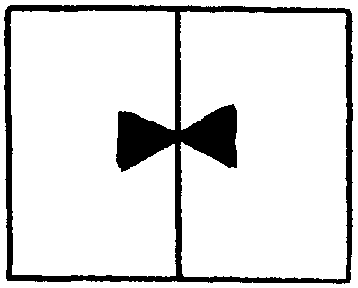
A gentleman's bow tie got stuck between the elevator doors.
What is on the picture?
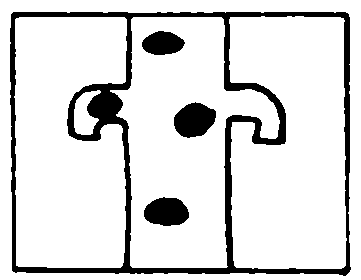
A giraffe has swallowed a telephone.
The question is formed by a minimal picture (regularly framed) drawn on a piece of paper together with a question What is on the picture?, the answer consists of a figurative
description of a phenomenon, object, action or situation depicted on the picture that is given in one word or a sentence. Droodles were particularly popular in the 1950s, when in
the US they acquired the name of "droodle" invented by Roger Price, who published his first book of visual riddles, Droodles, in 1953. The name droodle is a combination of the
words "drawing" and "doodle" (= a meaningless pattern or figure) (Kaivola-Bregenhoj 2001: 62). One of the oldest droodles or indovinelli grafici was drawn by the Italian painter
Agostino Carracci (1557-1602) representing a blind beggar behind a street corner:
![]()
Researches of short forms who work in the folklore department of the Estonian Literary Museum have compiled on the basis of card catalogue a big digital
database of the so-called classical riddles; the classification of the so-called peripheral riddle material has reached to the point, where modernization facilitates the future
work after the completion of the net version. Creating the database on the basis of the approximately 7500 text variants of droodles became the first touchstone of the
digitalization of the peripheral subtypes of riddles.
The technical realization of the droodles' database
As was mentioned above, the starting material of the database was the card catalogue where the researchers of short forms who work in the folklore department of Estonian Literary
Museum had compiled rdroodles from the collections of Estonian Folklore Archives; the latter were gathered since the beginning of the 1960s.
Ideally the database should consist of all droodles that have appeared in publications, but at the moment only droodles published in the books ”Banaanil
on nohu” (1995, compiled by E. Kalmre) and ”Neeger päevitab” (1996, compiled by A. Tuisk) can be found in digital form: droodles from both books belong to the same card catalogue
of Estonian Folklore Archives. A more consistent work with published droodles (especially with those plenty that have appeared in media) awaits its time.
Compared with regular databases, the creation and implementation of the droodle database is complicated by the presence of its visual side - the drawn picture.
During digitalization, the pictures were separated from the texts; each picture of the paper file was numbered. After the pictures were scanned, cut and
somewhat modified with graphics program GIMP (GNU Image Manipulation Program) each picture was placed as single gif-files to
the main catalogue of the database.
Texts were inserted to Excel-table, where one cell contained the number of the picture file that accompanied the droodle.
Digital database can be compared to the city of Tallinn that never gets completed; technically it is possible to constantly add new data. By May 2002,
7227 droodles have been digitalized.
Searching machine
The data are kept in the database system PostGreSQL, that the user accesses by means of perl script, the so-called
searching machine.
hrough the searching machine the user can generate droodles from the database according to the following attributes: a question, an answer, an archive
reference, a collector, the location of collection or topography, the time of collection or date and the subject.
The attribute of a question. When looking at the question and answer as form elements of a droodle, we can see that the question can also be divided into
two: in addition to the obligatory picture, also the verbal part could be added: What is on the picture? What is this?. This is not the case only with narrative droodles, where the
question consists of a long story and the answer is regularly limited to one word. Contents-wise the verbal question is rather uninformative for the user. In the performance
situation, at least in the beginning of riddling, the question is an obligatory supplement to the picture. Since the majority of droodles in the archive are pupils' answers to
written questionnaires, then the textual part of the question is not presented.
The attribute of an answer is the most informative for the user, since it contains figurative explanation to the drawing itself.
For instance, we know that a bear is one of the most productive characters of a droodle, but what about a bamboo bear? When we search the database,
we find two texts.
The attribute of an archive reference enables us to find a text by means of a unique archive reference, but it can also give an overview of the material
of a certain manuscript volume that on the basis of a card catalogue would be a time-consuming work.
The attribute of a location refers to the collection topography and is coded according to two aspects: first the home parish of an informant is given and then the known place of
origin is identified. Since in most cases the collectors of droodles are pupils, then it is necessary to also show the school - very often the local redactions of droodles are
made up of the material recorded from one school. Mostly the school remains within the boundaries of the home parish, but this is not always the case (Haapsalu Sanatoorne
Internaatkool and Nõo Reaalgümnaasium are schools, where children come to study from all over Estonia). The place of origin and the location of school are separated from each
other with a semicolon.
The attribute of a date enables us to search for droodles according to the year of collection. Initially, before the creation of the searching device, the
texts were also separated according to the date, therefore users can find from the main page an active link that leads to the results of this separation.
The attribute of subject was necessary in order to classify the card catalogue; it followed the two-dimensional nature of droodles (picture part - the
text part) and was needed in order to create some kind of structure in the card catalogue. Since it was impossible to arrange pictures into alphabetical order, then some
significant subject was picked up from the text and this text is found under this subject in the catalogue. It might appear strange for the user that in some cases the droodles
that contain the word cat are presented actually under the subject elephant. A limited number of subjects are available for the user and according to these it is possible to find
texts from the database.
The typological taxonomy of the droodles in the database
Although the searching machine that contains all of the identification data of droodles is an indispensable device for the user, its applications are not without limits.
Since the digitalization took place on the basis of an already classified card catalogue, then I considered it important that this would also be reflected
in the database. Therefore droodles have been separated also according to the typological taxonomy and from the main page a link goes to the types of droodles. There are more than
600 sets that are grouped on the basis of certain characteristics, which make up the types of droodles. Within one type variants converge around the text that is the most
characteristic and prototypic or 'typehead'. From the type row one can find also an archive reference to the 'typehead' text variant and the number of droodles on the respective
type. The redactions within a type or the overlapping variants of the type are made up of more or less identical pictures.
The database reflects the face of its creator and this becomes apparent primarily when looking at the breakdown of types. As is the case with any
classification of a folklore type, also droodles have some characteristic problems; thus, the database represents the typological decisions of its creator and therefore cannot
certainly be 100% objective.
The composition of redactions of droodles is multidimensional: during classification a choice had to be made whether to be based on a) varying part of
the question or b) varying part of the answer. It was impossible to consider both simultaneously, although this would have been highly desirable, and either had to be preferred
over another. Now the redactional breakdown of the database reflects very clearly the part of the question - the picture. Each similarly drawn picture from a subject under
research makes up one, separate redaction. The same picture can represent texts with very different variants of an answer.
Let us take a look at the 'king' of the types, the most numerous and common type, that contains
709
text variants - A bear is climbing up the tree. There are
301
similarly drawn pictures in this type, thus it also contains
301. redactions.
For instance, one redaction is made up of the
45.
text variants that are gathered under the picture of 0001.gif, under 0002.gif we can place
85 variants with the identical picture, 0003.gif has
1, 0004.gif has
2
texts, etc.
It is difficult to determine, what to do in borderline cases, when some picture is no longer a redaction of a type, but rather makes up an independent
type. When a user views the same A bear is climbing on a tree and rolls towards the end, s/he might want to ask, whether the last droodles are not already new types or are still
the redactions of the same type. When looking closer at the neighbor types (Bears are climbing up the tree, Bear cubs on the tree and A bear is carrying a beehive), one might
question, whether these should belong to the megatype A bear is climbing up the tree and not constitute new separate types.
At the moment they are placed in the database exactly this way as redactions; analogous redactions form also in any other type in the database. In any
case the way types are presented in the database poses a problem and needs to be considered further in the future..
Traditionality and improvisationality of droodles
During the creation of the database it was also interesting for the folkloristic point of view to look at the issues of traditionality and improvisationality of the material. Mall
Hiiemäe (1995) has touched upon this topic in her discussion of the creation principles of Estonian droodles.
As is characteristic to folklore, tradition and improvisation act in opposition: tradition attempts to maintain the text as it is and appears primarily in
common and large droodle types - children know a concrete answer for a certain picture.
The ranking of the most traditional (widely spread) types is the following::
1. |
156. tüüp [709 variants]
A bear is climbing up the tree [RKM, KP 11, 591 (7)] |
2.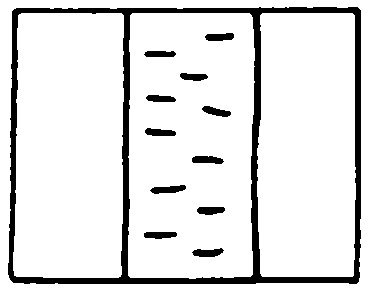 |
135. tüüp [700 variants]
A giraffe behind the window [RKM, KP 30, 357 (2a)] |
3.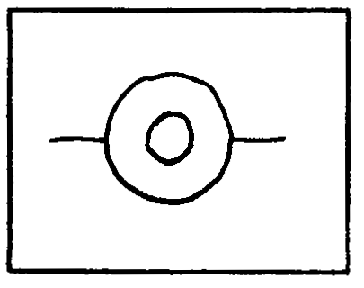 |
189. tüüp [550 variants]
A cowboy is riding a bicycle [RKM, KP 5, 406 (6)] |
4.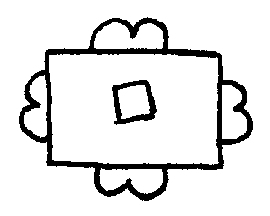 |
224. tüüp [286 variants]
Men were playing cards, one card fell under the table, now they are looking for it [RKM, KP 2, 523 (24)] |
5.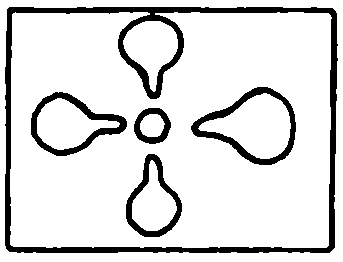 |
53. tüüp [270 variants]
Four elephants are sniffing at an orange [RKM, KP 11, 410 (16)] |
6. |
293. tüüp [220 variants]
A gammer is dragging a goat, but only the rope got to the picture [RKM, KP 21, 53 (3)] |
7.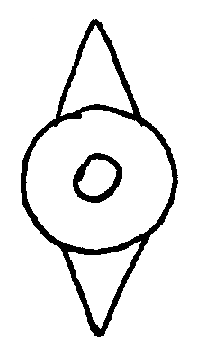 |
196. tüüp [186 variants]
A cowboy is riding a boat [RKM, KP 36, 360 (7)] |
8.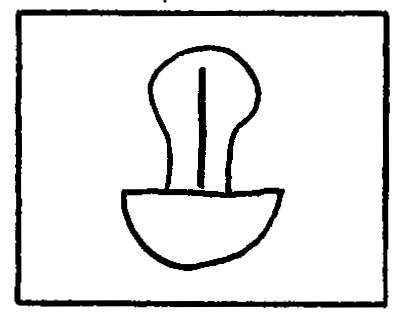 |
375. tüüp [155 variants]
Mother is washing her feet (from behind) [RKM, KP 43, 158 (9)] |
9.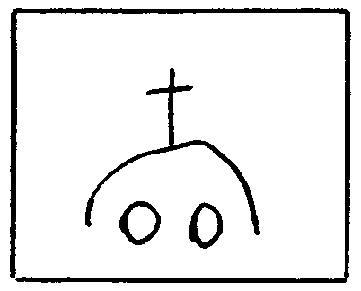 |
373. tüüp [148 variants]
An old gammer is praying [RKM, KP 1, 354 (2)] |
10.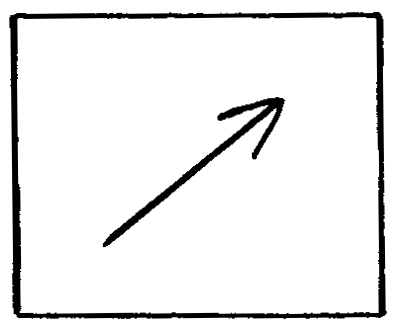 |
393. tüüp [134 variants]
An arrow [RKM, KP 3, 458 (2a)] |
11.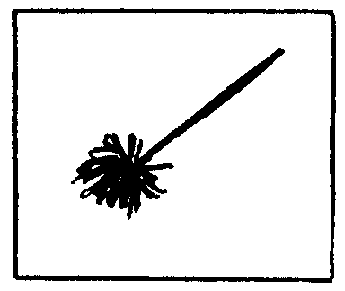 |
353. tüüp [131 variants]
A vehicle of a witch [RKM, KP 3, 359 (3a)] |
12. |
377. tüüp [118 variants]
A black in a dark room [RKM, KP 10, 5 (15)] |
13. |
92. tüüp [97 variants]
A hunter is walking with his gun and his dog [RKM, KP 44, 102 (6)] |
14.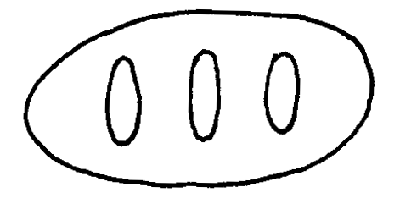 |
571. tüüp [83 variants]
They have to eat the white bread. [EFA II 7, 154 (1)] |
15.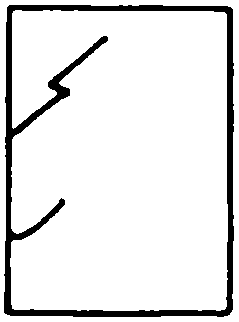 |
91. tüüp [82 variants]
A dog and a man, who’s got a gun with a bayonet on back, went inside through the door [EFA I 1, 85] |
However, when the text transforms, it could be called improvisation: regarding droodles this can happen in different levels.
1. The changes in the same type or text can come about in different times (different redactions of the same type or contaminations of two different types). .
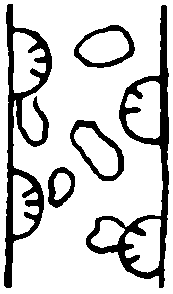 A bear is hugging a giraffe[RKM, KP 36, 56 (3i)]
A bear is hugging a giraffe[RKM, KP 36, 56 (3i)]2. At the same time a very common characteristic of droodles is the abundance of new independent types with only one text variant that arise from the old basis within categories. Therefore there is a huge numerical difference between common types (that with some reservations could be called traditional) and (more improvisational) one-text-types.
Zipf's model that is valid for several folklore genres and is the basic knowledge for linguists is applicable also for droodles. According to this model the most numerous types of a folklore genre are the ones that have only been recorded once; those recorded twice are already considerably less, etc. until in the other extreme of the scale there are big supertypes that are the least frequent (Krikmann 1997: 188).
droodles reflect exactly this tendency: two types with 700 variants (A bear is climbing up the tree, A giraffe behind the window) versus 300 types with one variant. Against the background of the total, widely spread types are actually very few.
More improvisational types (few text variants):
 Three musketeers and d'Artagnan. [RKM, KP 10, 155 (4)]
1 variant
Three musketeers and d'Artagnan. [RKM, KP 10, 155 (4)]
1 variant
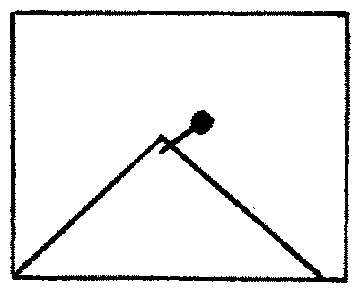 The painting by Shishkin 'Three bears'. [RKM, KP 11, 497 (7)]
1 variant
The painting by Shishkin 'Three bears'. [RKM, KP 11, 497 (7)]
1 variant
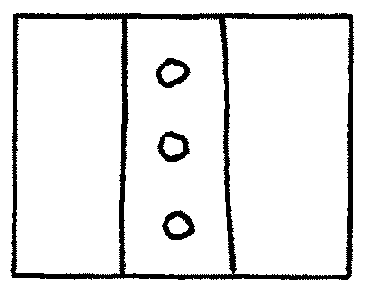 A watch strap in a box. [RKM, KP 4, 468 (1)]
1 variant
A watch strap in a box. [RKM, KP 4, 468 (1)]
1 variant
 A rabbit is jumping over the buck. [RKM, KP 28, 27 (4a)]
1 variant
A rabbit is jumping over the buck. [RKM, KP 28, 27 (4a)]
1 variant
 Two birds are flying in the clouds. [EFA II 7, 155 (7)]
1 variant
Two birds are flying in the clouds. [EFA II 7, 155 (7)]
1 variant
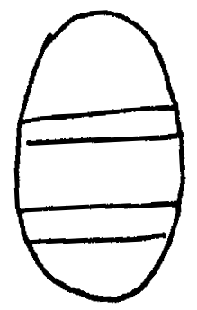 An egg in bikinis. [RKM 27, 278 (6)]
2 variants
An egg in bikinis. [RKM 27, 278 (6)]
2 variants
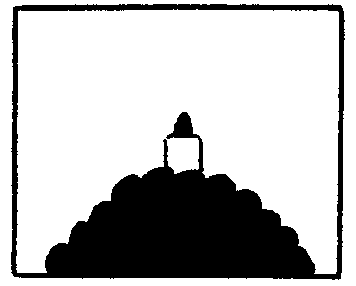 The nose of a mole. [RKM, KP 30, 688 ja 90 (14)]
1 variant
The nose of a mole. [RKM, KP 30, 688 ja 90 (14)]
1 variant
 Whites are staring at a black. [RKM, KP 4, 320 (11)]
1 variant
Whites are staring at a black. [RKM, KP 4, 320 (11)]
1 variant
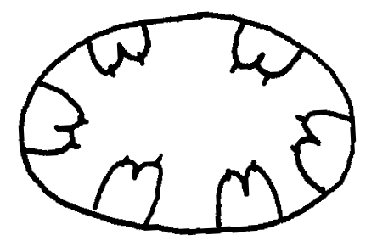 Women are bending to the bath. [RKM, KP 19, 438 (8)]
2 variants
Women are bending to the bath. [RKM, KP 19, 438 (8)]
2 variants
 A tomcat is blinking at a pussycat.. [RKM II 428, 143 (20)]
2 variants
A tomcat is blinking at a pussycat.. [RKM II 428, 143 (20)]
2 variants
The genre would also lose its relevance when only the large types (A bear is climbing up the tree and A Cowboy is riding a bike and A giraffe behind the window) would be endlessly recited. Given the classical reasons for improvisation were forgetting and the need for creating something new, then with respect to droodles the latter is essential. As we deal with school folklore, children are namely fascinated with one of the means of droodles - a chance to improvise, practice their own creation so that riddling would not be too easy and would fulfill its competitive function.
Figurativeness in droodles
When looking at the resources of the database, the user can also see that through improvisation droodles of questionable quality have been stored in the archives, which gives
raise to the questions of the existential nature of the droodles in general
Which picture is considered appropriate to name a droodle by a folklore researcher? What makes a picture a droodle in addition to its form
'picture-question-answer'? From folkloristic point of view, the most important element is its figurativeness. In a given case this is generally represented by the way simple
scribble pictures (which even the most beginner drawer would be able to scribble on a paper) give raise to the second meaning of the polysemous answers. At the same time this
polysemy can also be the intentional means for preventing the answerer to find the right solution.
In more simple terms you will draw a frame, make a horizontal line in the middle and ask from the other: What is this?

The reply A line (that is factually also true, but too simple, since the answerer is looking for a figure) does not bring a smile to the
researcher's face, but s/he will be happy to hear the next answers available in the database: A man is dragging a goat, but only the rope got to the picture, A postcard, A book
from the side, etc. An initially regular line attains an entirely different meaning when the logic mechanisms shift to another mode. In fact, one line can indeed mean anything
and finding the solution to the riddle becomes more complicated.
At the same time the database contains very many text variants that initially do not seem give a figure or second meaning. For example, let us take a look
at this large type:
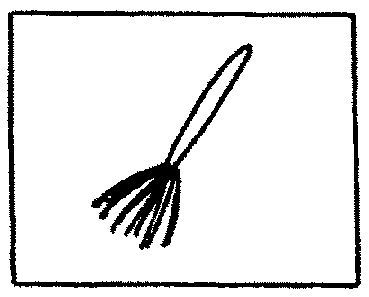
The vehicle of a witch [RKM, KP 3, 359 (3a)]
The majority of answers within this type that contain
131
text variants are direct and without a figure: A broom, A brush. A figure is present only in a few answers: A vehicle of a witch, No entrance for witches; the most interesting
with respect to the figure creation are two droodles presented as a series.
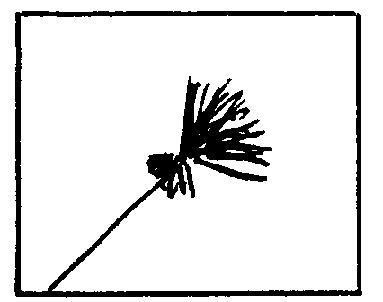
Baba-Jagaa (i.e. a Russian witch) is flying to the shop.
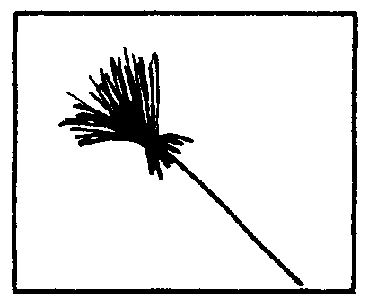
Baba-Jagaa (i.e. a Russian witch) is flying back home.
Each picture of the improvisational independent types with one or two text variants were drawn as accurately as possible in the database. When looking at some droodles, the user might be justifiably astonished and ask, ”What is funny about this?” However, I considered it important to present in the database also this kind of improvisation that has not come out very successfully. When we pay attention to these, we cannot speak about authenticity in its traditional folkloristic sense (when the workgroup of short forms compiled the academic publication of Estonian proverbs and classical riddles, the authenticity was very carefully checked for). Improvisation (one's own creation) is one of the peculiarities of the genre of droodles.
Summary
The database of Estonian droodles is a complete collection of droodles stored in Estonian Folklore Archives that should be of use both to the researchers
of the narrow field - folklorists - and a wider public - school children, who keep droodles in active circulation, school teachers, etc.
The data in the database could be broadly divided into three groups:
1) primary or real data, that reflect directly the reality or the real system;
2) secondary or metadata, that are the result of different transformations of the primary data;
3) organizational or supporting data, that enable one to structure the data in the database in certain ways.
I have reached with my work to the point where the primary or the real data have been digitalized and the structure created for the database and technical
realization make it possible to constantly add new material and improve the database. With the help of different methods and programs it is possible to further transform the
primary data and get results that would be complicated if not impossible through working with a card catalogue.
When summarizing what was said above I also have to answer the question, what the use of the droodles and contemporary riddles is. Whether and why to
discuss them, for example, in school classes and give feedback to children about their activities?
Folklore is better to teach exactly by starting with the introduction of the contemporary material, because this is familiar to the children. The pupils
see that they themselves can be the creators and bearers of folklore. It is safe to say that whereas the resigning classical riddles that belonged to the repertoire of adults in
the peasant folklore and even posed a magical function (thus, riddling in the winter before the midwinter and Christmas time brought luck to the cattle), the contemporary riddles
are children's folklore. Adults know and practice them today mostly together or in connection with children. In addition droodles develop children's thinking and creativity. It
would not be wrong for an adult to see sometimes things in the way children see, to facilitate this kind of ability to see things differently and to encourage children to be
creative.
We all remember how the main character in the book ”A Little Prince” by French author Antoine de Saint-Exupery became sad when adults could not understand
the meaning of the pictures he had drawn. These pictures have also reached the droodle folklore of our children and make up two fairly productive types:

This is not a hat, like an adult would guess, but a boa, who digests an elephant.
And the other one:

Believe me, this is exactly sheep, only inside the box!
Knowing traditional droodles, children create new ones. Those with the best contents or idea survive and in their turn start to circulate among people
(read: children) and establish themselves in tradition. Therefore the tradition through improvisation creates new droodles and gives new research material for folklore researchers.
Literature
Hiiemäe, Mall 1995. Eesti piltmõistatuste loomispõhimõtetest. -- Lipitud-lapitud, tänapäeva folkloorist. Tartu, lk 23-32.
Kaivola-Bregenhoj, Annikki 2001. Riddles: Perspectives on the use, function and change in a folklore genre. Studia Fennica Folkloristica 10. Helsinki : Finnish
Literature Society.
Kalmre, Eda 1995. Banaanil on nohu. Valik koolinalju ja muud. Tallinn.
Krikmann, Arvo 1997. Sissevaateid folkloori lühivormidesse I. Põhimõisteid, žanrisuhteid, üldprobleeme. Tartu, lk 187-193.
Lipponen, Ulla 1997. Sika sumussa. Kuva-arvoituksia. Hämeenlinna.
Tuisk, Astrid 1998. Neeger päevitab. Maailma rahvad Eesti laste naljades. Tallinn.
Voolaid, Piret 2003. Kaelkirjak akna taga. Põimik piltmõistatusi. Tallinn.
Voolaid, Piret 2009. Narrative Droodles as Humorous Miniature Fairy Tales. Acta Ethnographica Hungarica, 54, pp. 143-154.
Links
http://www.cut-the-knot.org/ctk/Droodle.shtml
Archimedes' Laboratory